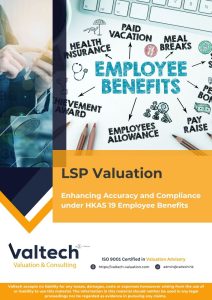Valtech Valuation Expertise in LSP Valuation Services in Hong Kong
Valtech’s valuation team includes Master of Finance, Master of Statistics and valuation experts with background in quantitative finance and financial engineering. In the context of long service payment valuation, Valtech’s valuation programme has been reviewed by a qualified fellow actuary to improve model accuracy and prevent errors.
Client References of Valtech’s Actuarial Model for HKAS 19 Employee Benefits Regarding Long Service Payment or Severance Payment
- Multinational corporation’s (MNC’s) Hong Kong office in publication sector
- MNC’s Hong Kong office in production sector
- MNC’s Hong Kong office in telecommunication sector
- An international law firm’s Hong Kong office
- A company with approximately ten thousands of staff in Hong Kong
- A famous medical group in Hong Kong
- MNC’s Hong Kong business in clothing and baby products
- MNC’s Hong Kong business in building product
- The Hong Kong office of a MNC, with headquartered in USA
- A MNC headquartered in Austria in electronics trading industry
- A hotel group in Hong Kong
- Non-governmental Organisations (NGOs) in Hong Kong
- An organisation with both voluntary MPF and ORSO scheme (a complex case that requires consideration of complicated offsetting issues)
- The list above is non-exhaustive.
The details of the abolition of MPF offsetting arrangement could be referred below:
https://www.op.labour.gov.hk/en/government-scheme.html
Abolition of Offsetting Arrangement (to be implemented in 2025)
The Legislative Council passed the Employment and Retirement Schemes Legislation (Offsetting Arrangement) (Amendment) Bill 2022 on 9 June 2022 to abolish the use of the accrued benefits of employers’ mandatory contributions under the Mandatory Provident Fund (MPF) System to offset severance payment (SP) and long service payment (LSP) (the offsetting arrangement). The Government will implement the abolition of the offsetting arrangement in tandem with the full implementation of the eMPF Platform of the Mandatory Provident Fund Schemes Authority, which is expected to be in 2025.
Key points of the abolition of offsetting arrangement:
- After the abolition of the offsetting arrangement takes effect (the transition date), employers can no longer use the accrued benefits derived from their mandatory MPF contributions to offset employee’s SP/LSP;
- Accrued benefits derived from employers’ voluntary contributions as well as gratuities based on length of service can continue to be used to offset SP/LSP.
- To reduce the risk of large-scale dismissals before the transition date, the “grandfathering” arrangement will be put in place for the pre-transition portion of SP/LSP of employees who are already in employment before the transition date.
Key points of the “grandfathering” arrangement (only applicable to employees who are already in employment before the transition date):
- For employees already in employment before the transition date, their SP/LSP will be divided into pre-transition portion (i.e. for the employment period before the transition date) and post-transition portion (i.e. for the employment period starting from the transition date).
- The pre-transition portion will be calculated on the basis of the monthly wages immediately preceding the transition date and the years of service before the transition date, whereas the post-transition portion will be calculated on the basis of the last monthly wages before termination of employment and the years of service after the transition date.
- The maximum amount of SP/LSP (i.e. the sum of pre-transition and post-transition portions of SP/LSP) is still capped at $390,000. If an employee’s total SP/LSP exceeds $390,000, the amount in excess of the cap will be deducted from the post-transition portion.
- Employers can continue to use the accrued benefits derived from their MPF contributions (irrespective of whether the contributions are made before, on or after the transition date, and irrespective of whether the contributions are mandatory or voluntary) to offset the pre-transition portion (but not the post-transition portion) of SP/LSP.
After the abolition of the offsetting arrangement, calculation of SP/LSP payable to a monthly-rated employee is as follows:
(1) Employment period before transition date
- Employee’s last full month’s wages immediately preceding the transition date× 2/3 × years of service before transition date
(2) Employment period after transition date
- Employee’s last full month’s wages before termination of employment× 2/3 × years of service after transition date
(3) The ceiling on the monthly wages for calculating SP/LSP is $22,500 and the maximum SP/LSP amount is $390,000. These ceilings remain unchanged.
Subsidy Scheme for Abolition of MPF Offsetting Arrangement
How to determine whether a case falls within the $500,000 threshold?
The $500,000 threshold refers to whether the accumulated amount of post-transition portion of SP/LSP payable by an employer during the same year exceeds $500,000.
Employers should pay SP/LSP to employees in accordance with the Employment Ordinance and then submit applications for disbursement of Government subsidy. In short, employers should get prepared and reserve liquidity to pay for the full amount of liabilities in SP/LSP before they can claim the disbursement.







